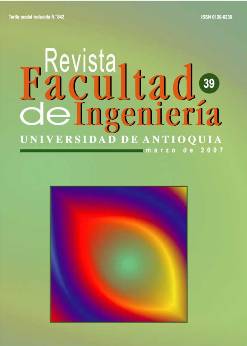Physicochemical and biological characterization of Sea Water in Mamonal zone (Cartagena Bay) for static antifouling paint testing
DOI:
https://doi.org/10.17533/udea.redin.20186Keywords:
biofouling, Cartagena Bay, antifouling paints, sea water characterizationAbstract
The incrustation of marine organisms (biofouling) affect several submerged metallic structures, like ship hulls. Biofouling frequently induces metal corrosion, reduces the speed of displacement, increases fuel consumption, and increases the frequency of dry-dock operations. Antifouling paints which have the capacity to prevent the marine organisms from contacting the painted surface (by means of biocide release), have been developed in order to mitigate these deleterious effects. Static tests of antifouling paints include immersing painted panels (attached to floating structures), and periodically evaluating its performance. Before conducting these static tests, it is important to characterize the local maritime environment by determining the range of values of the most significant physical, chemical and biological variables. A complete characterization of the sea water in the zone of Mamonal (Cartagena Bay) was conducted; variables such as solar irradiation, light availability, dissolved oxygen, temperature, pH, redox potential, alkalinity, and salinity were measured. In addition, the determination and quantification of the main biological entities present in the samples was also carried out.
Downloads
References
R. Bastida, G. Brankevich. “Las comunidades incrustantes”. Ciencia Hoy. Vol. 1. 1989. pp. 74-75.
M. Pérez, M. Stupak. “El conocimiento del “biofouling”. Un aspecto importante para el desarrollo de pinturas antiincrustantes eficientes. Color & Textura. Vol. 64. 2000. pp. 8-11.
M. Callow, J. Callow. “Marine biofouling: a sticky problem”. Biologist (London). Vol. 49. 2002. pp.1-5.
C. A. Giudice, J. C. Benítez, V. Rascio. “Prevención del fouling en carena de embarcaciones con pinturas AF a base de resina colofonia y caucho clorado”. Revista Iberoameri-cana de Corrosión y Protección. Vol. XV. 1984. p. 16.
J. C. Benítez, C. A. Giudice, V. Rascio. “Binders of self polishing antifouling paints”. European Coatings Journal. Vol. 11. 1990. pp. 618-631.
C. A. Giúdice, B. del Amo, V. Rascio. “The use of calcium resinate in the formulation of soluble matrix antifouling paints based on cuprous oxide”. Progress in Organic Coatings. Vol. 16. 1988. pp. 165-176. DOI: https://doi.org/10.1016/0033-0655(88)80012-8
C. A. Giúdice, B. del Amo. “Influencia de la velocidad de disolución del ligante sobre el comportamiento de pinturas antiincrustantes tipo matriz soluble”. Anales CIDEPINT. 1993. pp. 1-12.
D. Meseguer, S. Kiil, K. Dam-Johansen.“Antifouling technology-past, present and future steps towards efficient and environmentally friendly antifouling coatings”. Pro-gress in Organic Coatings. Vol. 50. 2004. pp. 75-104. DOI: https://doi.org/10.1016/j.porgcoat.2003.06.001
A. Socci. “What to consider when testing marine paints”. Journal of Protective Coatings and Linings. Vol 21. 2004. pp. 23-27.
R. Wetzel, G. Likens. Limnological Analysis. Third ed. New York. Springer Verlag. 2000. pp. 18-21. DOI: https://doi.org/10.1007/978-1-4757-3250-4
R. Megalef. Limnología. Barcelona. Ed. Omega. 1983. pp. 272-274.
D. Jenkins. Química del agua. México. Ed. Limusa. 1995. pp. 15-16.
G. Linder. Muscheln und Schnecken der Weltmeer. München, Germany. BLV Verlagsgesellschaft mbH. 1999. pp. 176-303.
E. Otero. Corrosión y degradación de materiales. Madrid. Ed. Síntesis. 1997. pp. 204-210.
D. Jones. Principles and prevention of corrosion. New York. MacMillan Publishing. 1992. pp. 383-385.
D. Todd, B. H. Ketchum. Marine fouling and its prevention. Woods Hole, USA. Woods Hole Oceanographic Institution. 1952. pp. 306-308.
Downloads
Published
How to Cite
Issue
Section
License
Revista Facultad de Ingeniería, Universidad de Antioquia is licensed under the Creative Commons Attribution BY-NC-SA 4.0 license. https://creativecommons.org/licenses/by-nc-sa/4.0/deed.en
You are free to:
Share — copy and redistribute the material in any medium or format
Adapt — remix, transform, and build upon the material
Under the following terms:
Attribution — You must give appropriate credit, provide a link to the license, and indicate if changes were made. You may do so in any reasonable manner, but not in any way that suggests the licensor endorses you or your use.
NonCommercial — You may not use the material for commercial purposes.
ShareAlike — If you remix, transform, or build upon the material, you must distribute your contributions under the same license as the original.
The material published in the journal can be distributed, copied and exhibited by third parties if the respective credits are given to the journal. No commercial benefit can be obtained and derivative works must be under the same license terms as the original work.










 Twitter
Twitter